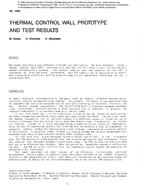Pressurization (blower door) test is a well-established standardized method, performed in order to quantify the total leakage in a building envelope. However, blower door results are not adequate to use when air leakage through the building envelope during natural conditions (non-pressurized) is to be estimated. A common assumption made when estimating air leakage during natural conditions, is that air leakage paths are evenly distributed in the areas of the building envelope. This assumption gives quite poor calculation results since different leakage configurations are often situated unevenly in the envelope. In order to improve the correspondence between Blower door and air leakage model results, more information on the types and locations of the leakage paths are required as input to simulation models.This paper investigates if additional information from visual inspection and IR-thermography observations at site can increase the precision when simulating air change rates due to air leakage in natural conditions. A numerical model is developed in this study by allocating leakage in various parts of the building envelope. The leakage allocation is based on visual inspection and IR-thermography observations at the site during the blower door test.This procedure is tested in the case study of a large single zone church. Blower door, neutral pressure level measurement and leakage allocation results are used as input in the numerical model. Model results are compared with tracer gas measurements and result accuracy is compared with results from the Lawrence Berkeley Laboratory model (LBL) and the Alberta Air Infiltration Model (AIM-2) for the same church.
Citation: ASHRAE and AIVC IAQ 2016 Conf
Product Details
- Published:
- 2016
- Number of Pages:
- 8
- Units of Measure:
- Dual
- File Size:
- 1 file , 1.9 MB
- Product Code(s):
- D-2016IAQ-30


